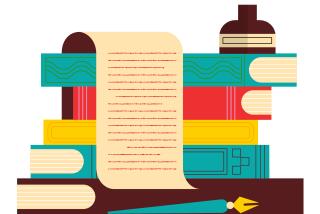Tea With Mussolini
- Share via
“I hate ‘abroad,’ ” Lord Redesdale once announced to his Mitford daughters, voicing a sentiment shared by many of his fellow Britons. Florence was the one exception to a primal English aversion to foreignness. From the middle of the 19th century on, the city on the banks of the Arno was expat paradise to an entire class of Anglo-American wealth. Cheap labor and real estate allowed the rich to live in feudal splendor, permitting even their followers, like art historian Bernard Berenson, to assume the trappings of seigneurial style.
By 1911, Caroline Moorehead tells us in “Iris Origo: Marchesa of Val d’Orcia,” her richly satisfying life of the writer and biographer, there were, incredibly, 35,000 English living in or around Florence. Her hills were alive with the sound of clinking teacups and the drone of upper-class Edwardian speech.
Born in London in 1902 and raised in this culture of chosen exile, Iris Cutting seems to have sprung fully formed from the pages of a Henry James novel. An only child, she was heiress to new fortunes on one side of the Atlantic and granddaughter of the Anglo-Irish ascendancy on the other. Her American father, Bayard Cutting, scion to vast wealth from real estate and railroads, had made the classic Gilded Age match, wedding the daughter of Lord Desart.
A promising young diplomat, Cutting died of tuberculosis when his daughter was 7. To escape both families, his widow Sybil settled in Florence and became one of its reigning deities.
Clever and plain, Iris would never be a belle, and her mother sensibly allowed her friend Berenson to provide the girl with a noted classicist as a tutor. While Iris was learning Greek and Latin, Sybil, with the help of her lover, landscape architect and writer Geoffrey Scott, turned her property, the Villa Medici in Fiesole, into a showplace of garden design and historic reconstruction.
With few companions her own age, bookish and socially awkward, Iris would inevitably fall for a fortune hunter; Marchese Antonio Origo had little to recommend him but his title. Both Protestant sides of the girl’s family were horrified by Iris’ choice: a Roman Catholic, and the illegitimate son of a cavalryman. But the smitten 20-year-old prevailed and the couple were married in the Medici chapel on the grounds of the villa. Sybil remained in bed with a migraine.
Predictably, the marriage was unhappy from the start. The pair had nothing in common, and although Moorehead describes Origo as a “sportsman,” his athletics were confined to the usual pastime of men of his class: philandering. Iris, too, soon found consolation elsewhere. What kept them together more than nominally was their purchase of an unpromising parcel of arid land in Val d’Orcia, a remote corner of Tuscany. “La Foce” was a miserable collection of hardscrabble farms where the peasantry eked out a subsistence living from the thin-soiled steep cliffs--”like a lunar landscape” the new owners said happily--virtual slaves to the ancient system of tenancy called padronage.
Settling in La Foce, the Origos reinvented themselves as model landowners and agrarian reformers. With the wedding present of a pipeline from a Cutting aunt, water from the valley turned the chalky terraces into flourishing farms. (What God could do if He had money!) Iris’ investment in reclaiming Val d’Orcia provided an incompatible couple with complementary roles. Antonio presided over the agricultural innovations: new tractors, irrigation, livestock; Iris applied her intelligence and energy to organizing a primary school, decent housing and medical care for the workers and their families. Then, in June 1924, as if to bless their collaboration, the Origos’ first child, a son, Giovanni “Gianni” Clemente, was born.
Another benediction, this one, political, was soon bestowed. Early in his climb to power, Mussolini recognized how much he needed the support of Italy’s aristocratic families with their vast land holdings. The transformation of Val d’Orcia by a noble landowner and his rich foreign wife was the model enterprise he sought.
Touting the agrarian reforms at La Foce and the paternalistic success of its owners, Il Duce diverted attention from his betrayal of earlier promises to redistribute agricultural wealth. In the course of several well-publicized visits, uniformed Fascist dignitaries honored a smiling Black-Shirted Antonio, while Mussolini himself exalted the work of the padrona as extending the dictatorship’s ideal of domesticity into the public sphere.
Fascism was no moral stretch for the marchese, an arch-conservative, monarchist and anti-Semite. Iris’ views are cloaked in silence. In her many letters from the late 1920s and early ‘30s--years before censorship would have been an issue--she made not a single allusion to the spreading evils of the regime: neither adventurism abroad nor at home, the debasement of language, suppression of dissent and constitutional rights, racial laws, sanctioned thuggery, not even the flight or deportation of liberal friends. As to Mussolini, her few comments are admiring: Fluttery frissons greet Il Duce’s striding macho progress through a roomful of effete aristocrats: “My dear, he is a very great man,” she advised a doubting English friend.
Amazingly, between her duties as padrona and socialite, the hunting parties at home and extended trips to America and England, the expeditions lasting months to remote climes whose planning of camels and bearers would have stymied Lawrence of Arabia, Iris Origo found time to become a writer.
She had long meditated a biography of the poet Giacomo Leopardi, a reclusive hunchback whose inner exile spoke to her own sense of being an outsider in the country where she had lived since childhood. Constantly interrupted, her work on the book had been lastly deferred by her son’s birth; it was Gianni’s death in 1932 that forced its completion.
Guilt compounded the devastation of loss. The 8-year-old boy had wasted away for 58 days before dying of undiagnosed meningitis. Local doctors had been consulted--even a clairvoyant living in the English town of Harrow--but it never seems to have occurred to his parents, who buzzed off in private railway cars to Swiss clinics and Harley Street specialists for a lingering cough, to seek more sophisticated medical care for their child.
Three years later, “Leopardi: A Study in Solitude,” was published in London to admiring notices on both sides of the Atlantic. Its author’s avoidance of the “too personal” was found to be especially commendable. Today, Origo’s life of the poet feels authoritative and intelligent but cold--its author still frozen in the first shock of grief.
Meanwhile, the tragedy had further estranged an already distant couple: There were quarrels and new affairs. But at least Iris’ writing ceased to be a furtive activity; she no longer cared that Antonio loathed literary women. In contrast, Origo’s next subject unlocked in her a wellspring of imaginative sympathy. “Allegra” is a brief “memoir” of Byron’s “little illegitimate,” his daughter with Claire Clairmont. Dead at 5 years old, the beautiful “child of fashion and sin” was a sacrifice to parental hostilities. An instrument of her father’s revenge on his importunate mistress, she was left to sicken and die in an insalubrious convent, unvisited by either parent. No book has stronger claims as an act of penance.
Origo had found her voice and, in the process, forged her own genre of biography. Like La Foce itself, her “lives” are reclamations, a seamless join of historical research and the storyteller’s art. Only the endless, painfully revised drafts among her papers confound our sense of an effortless style, our certainty that she couldn’t write an ugly sentence.
Whether making human the most sentimentalized of saints, as in her life of San Bernardino, or summoning a vital 14th century merchant of Prato from a roomful of crumbling documents, Origo brought the foreigner’s curiosity to that other country, the past.
In “The Last Attachment,” the story of Byron and the Countess Teresa Guiccioli, Origo’s deep knowledge of the history and mores of 19th century Italy and her own roots elsewhere focus her double perspective. Evoking Byron’s isolation in provincial Ravenna, his political education under a police state, his life as a series of exiles with his mistress’ family, Origo speaks from her own equivocal experience.
Two years earlier, in 1947, she had published the book that vaulted her from scholarly obscurity. “War in Val d’Orcia” was the story that a postwar culture wanted to hear: an inspiring memoir of sacrifice and heroism shared by the entire La Foce community, led by the Origos’ risky work of hiding and feeding Allied troops and local partisans. Some saw the book as a whitewash of Antonio’s Black-Shirted past and the author’s own acquiencent silence. With Mussolini’s defeat, everyone was a partigiano.
Moorehead’s treatment of the political dimensions of Origo’s life, evenhanded and honest, is only one of the virtues of her exemplary authorized biography. She captures the giddiness of pre-war Florentine society, its musical beds and warring salonistas, along with the deep sadness of Origo’s last years, which neither two daughters, her own last attachment of friendship with a great and noble woman, reconciliation with Antonio nor conversion to Catholicism could assuage. If there is an absence at the heart of Moorehead’s book, it is there within Origo--hers a restless and incomplete life, fleetingly consoled by art.
More to Read
Sign up for our Book Club newsletter
Get the latest news, events and more from the Los Angeles Times Book Club, and help us get L.A. reading and talking.
You may occasionally receive promotional content from the Los Angeles Times.










